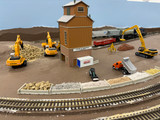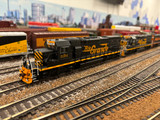Chicago, the Rail Hub: A History of the Chicago and North Western Railway
Chicago, often referred to as the "Windy City," is a metropolis that has played a pivotal role in the development of the United States' transportation infrastructure. At the heart of this development is the Chicago and North Western Railway (C&NW), a historic rail company that left an indelible mark on the Midwest's industrial and economic landscape. In this article, we will delve into the fascinating history of Chicago's rise as a rail transportation hub, the growth and expansion of the Chicago and North Western Railway, and the C&NW's lasting legacy in the Midwest.
Chicago's Rise as a Rail Transportation Hub
- The Early Days
- Chicago's emergence as a rail transportation hub can be traced back to the mid-19th century. As settlers and industries began to spread westward, Chicago's strategic location at the southwestern tip of Lake Michigan made it an ideal location for connecting the East Coast with the burgeoning Western frontier. In 1848, the Galena and Chicago Union Railroad was established, marking the city's first major railroad.
- The mid-1800s saw an explosion of railroad construction in and around Chicago. The city became a focal point for multiple railroads, including the Illinois Central, Michigan Central, and the Chicago, Burlington and Quincy. These railroads converged in Chicago, facilitating the movement of goods and people from all corners of the country.
- Railroad Boom
- Importance of the Rail Hub
- Chicago's role as a rail hub was solidified during the Civil War when the city served as a critical transportation center for moving troops and supplies. The rapid growth of the city's rail network also contributed significantly to its economic development. By the late 19th century, Chicago had earned its reputation as the "Railroad Capital of the World."
- Importance of the Rail Hub
The Growth and Expansion of the Chicago and North Western Railway
- Foundation and Early Growth
- The Chicago and North Western Railway, commonly known as the C&NW, was chartered in 1859. Initially, it operated as a small regional railroad serving communities in Illinois and Wisconsin. However, under the visionary leadership of Marvin Hughitt, who became the company's president in 1887, the C&NW embarked on an ambitious expansion plan.
- Expanding Westward
- The C&NW's most significant expansion came in the late 19th and early 20th centuries when it pushed westward, connecting Chicago to the Great Plains and beyond. The company extended its lines into Iowa, Nebraska, South Dakota, and even Wyoming. This expansion facilitated the movement of agricultural products, livestock, and minerals from the Midwest to the rest of the country.
- Innovation and Modernization
- The C&NW was at the forefront of technological advancements in the rail industry. It embraced innovations such as steel bridges, diesel-electric locomotives, and streamlined passenger trains, providing faster and more efficient transportation services. These advancements not only improved the company's operations but also set industry standards.
The C&NW's Legacy in the Midwest
- Economic Impact
- The Chicago and North Western Railway played a vital role in the economic development of the Midwest. Its extensive rail network facilitated trade and commerce, enabling the region's agricultural and industrial sectors to flourish. The C&NW's presence also led to the growth of numerous towns and cities along its routes.
- Cultural Impact
- The C&NW left a lasting cultural imprint on the Midwest. The iconic "400" passenger train, known for its speed and luxury, became synonymous with the company and contributed to the region's sense of identity. The railroads also played a role in shaping the culture of the American West, as they facilitated westward expansion and settlement.
- Legacy Today
- Although the Chicago and North Western Railway ceased independent operations in 1995 when it merged with the Union Pacific, its legacy lives on. Many of its former routes are still in use, and the company's impact on the Midwest's transportation and economy is still felt today. Railroad enthusiasts and historians continue to study and celebrate the history of the C&NW, ensuring that its story is preserved for future generations.
In conclusion, the Chicago and North Western Railway played a pivotal role in Chicago's rise as a rail transportation hub and left an enduring legacy in the Midwest. From its humble beginnings as a regional railroad to its extensive network connecting Chicago to the Western frontier, the C&NW's history is a testament to the power of railroads in shaping the destiny of a nation. Its impact on the economy, culture, and infrastructure of the Midwest continues to be celebrated, reminding us of the enduring legacy of this remarkable railroad company.
Recent Posts
-
Enhancing Your Model Railroad: Adding Spectacular Special Effects
Embarking on the journey of model railroading opens up a world of creativity and craftsmanship, wher
-
All Aboard the Wisdom Express: Life Lessons from Model Railroading
Embarking on the journey of model railroading opens the door to a world where imagination meets prec
-
Capturing History in Miniature: The Art of Prototype Modeling in the Model Railroad World
Prototype modeling in the model railroad world involves creating miniature replicas of real-life tra




